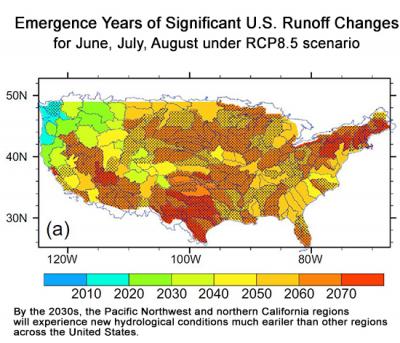Future Climate Warming Induces Emergence of New Hydrologic Regimes of Surface Water Resources in the Conterminous United States
Future climate change projections often focus on average trends over time, or zero in on changes in extreme events. When evaluating climate change impacts, however, it is often important to consider additional parameters, such as changes in the seasonality of runoff. This study evaluates whether the overall pattern of surface water supply in a given watershed has shifted significantly away from historical conditions—that is, when it is projected to enter a new “hydrological regime”— using a statistical technique, and finds that more than 40% of the continental United States land area is likely to experience a significant hydrological regime shift by the end of the 21st century.
Many human and natural systems have evolved in the context of a relatively stable climate, so it is important to understand when and where climate change could push systems across thresholds that would result in rapid, nonlinear changes. This study assessed changes in the probability distributions of surface water resources in large (HUC-4) sub-basins across the United States under a range of future climate projections. The research found that each 1°C increase in global mean temperature was associated with an 11-17% increase in land area experiencing a new hydrologic regime, which could pose significant challenges to water resource managers. Northern California and the Pacific Northwest are projected to experience these regime shifts by 2030, earlier than other US regions.
Researchers at the Department of Energy’s Pacific Northwest National Laboratory (PNNL) analyzed runoff projections from the Variable Infiltration Capacity (VIC) hydrological model which was driven by 97 downscaled and bias-corrected Coupled Model Intercomparison Project Phase 5 (CMIP5) climate projections over the conterminous United States (CONUS). A statistical technique based on the two-sample Kolmogorov-Smirnov test was used to determine the year in which the summer and winter surface runoff in each sub-basin shifted to a new regime in each of these projections, compared to the simulated historical hydroclimate from 1970-1999. They found that the overall land area experiencing a significant hydrologic regime shift followed a linear relationship with respect to global mean temperature, with 11-17% more lands experiencing statistically significant changes in winter and summer runoff across all scenarios and models considered. Further decomposition showed that the emergence of new runoff regimes is typically dominated by changes in variability, rather than shifts in average runoff, and that these runoff regime shifts are driven by an increase in the year-to-year variability of precipitation across many future climate scenarios.

